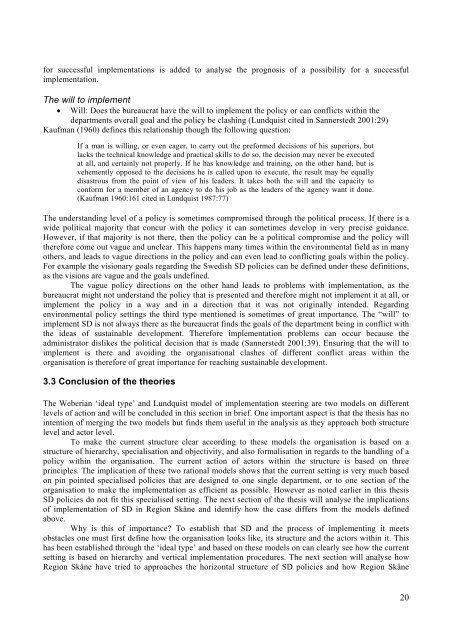From 'grey to green'- investigating the capabilities of the ... - lumes
From 'grey to green'- investigating the capabilities of the ... - lumes
From 'grey to green'- investigating the capabilities of the ... - lumes
Create successful ePaper yourself
Turn your PDF publications into a flip-book with our unique Google optimized e-Paper software.
for successful implementations is added <strong>to</strong> analyse <strong>the</strong> prognosis <strong>of</strong> a possibility for a successfulimplementation.The will <strong>to</strong> implement• Will: Does <strong>the</strong> bureaucrat have <strong>the</strong> will <strong>to</strong> implement <strong>the</strong> policy or can conflicts within <strong>the</strong>departments overall goal and <strong>the</strong> policy be clashing (Lundquist cited in Sannerstedt 2001:29)Kaufman (1960) defines this relationship though <strong>the</strong> following question:If a man is willing, or even eager, <strong>to</strong> carry out <strong>the</strong> preformed decisions <strong>of</strong> his superiors, butlacks <strong>the</strong> technical knowledge and practical skills <strong>to</strong> do so, <strong>the</strong> decision may never be executedat all, and certainly not properly. If he has knowledge and training, on <strong>the</strong> o<strong>the</strong>r hand, but isvehemently opposed <strong>to</strong> <strong>the</strong> decisions he is called upon <strong>to</strong> execute, <strong>the</strong> result may be equallydisastrous from <strong>the</strong> point <strong>of</strong> view <strong>of</strong> his leaders. It takes both <strong>the</strong> will and <strong>the</strong> capacity <strong>to</strong>conform for a member <strong>of</strong> an agency <strong>to</strong> do his job as <strong>the</strong> leaders <strong>of</strong> <strong>the</strong> agency want it done.(Kaufman 1960:161 cited in Lundquist 1987:77)The understanding level <strong>of</strong> a policy is sometimes compromised through <strong>the</strong> political process. If <strong>the</strong>re is awide political majority that concur with <strong>the</strong> policy it can sometimes develop in very precise guidance.However, if that majority is not <strong>the</strong>re, <strong>the</strong>n <strong>the</strong> policy can be a political compromise and <strong>the</strong> policy will<strong>the</strong>refore come out vague and unclear. This happens many times within <strong>the</strong> environmental field as in manyo<strong>the</strong>rs, and leads <strong>to</strong> vague directions in <strong>the</strong> policy and can even lead <strong>to</strong> conflicting goals within <strong>the</strong> policy.For example <strong>the</strong> visionary goals regarding <strong>the</strong> Swedish SD policies can be defined under <strong>the</strong>se definitions,as <strong>the</strong> visions are vague and <strong>the</strong> goals undefined.The vague policy directions on <strong>the</strong> o<strong>the</strong>r hand leads <strong>to</strong> problems with implementation, as <strong>the</strong>bureaucrat might not understand <strong>the</strong> policy that is presented and <strong>the</strong>refore might not implement it at all, orimplement <strong>the</strong> policy in a way and in a direction that it was not originally intended. Regardingenvironmental policy settings <strong>the</strong> third type mentioned is sometimes <strong>of</strong> great importance. The “will” <strong>to</strong>implement SD is not always <strong>the</strong>re as <strong>the</strong> bureaucrat finds <strong>the</strong> goals <strong>of</strong> <strong>the</strong> department being in conflict with<strong>the</strong> ideas <strong>of</strong> sustainable development. Therefore implementation problems can occur because <strong>the</strong>administra<strong>to</strong>r dislikes <strong>the</strong> political decision that is made (Sannerstedt 2001:39). Ensuring that <strong>the</strong> will <strong>to</strong>implement is <strong>the</strong>re and avoiding <strong>the</strong> organisational clashes <strong>of</strong> different conflict areas within <strong>the</strong>organisation is <strong>the</strong>refore <strong>of</strong> great importance for reaching sustainable development.3.3 Conclusion <strong>of</strong> <strong>the</strong> <strong>the</strong>oriesThe Weberian ‘ideal type’ and Lundquist model <strong>of</strong> implementation steering are two models on differentlevels <strong>of</strong> action and will be concluded in this section in brief. One important aspect is that <strong>the</strong> <strong>the</strong>sis has nointention <strong>of</strong> merging <strong>the</strong> two models but finds <strong>the</strong>m useful in <strong>the</strong> analysis as <strong>the</strong>y approach both structurelevel and ac<strong>to</strong>r level.To make <strong>the</strong> current structure clear according <strong>to</strong> <strong>the</strong>se models <strong>the</strong> organisation is based on astructure <strong>of</strong> hierarchy, specialisation and objectivity, and also formalisation in regards <strong>to</strong> <strong>the</strong> handling <strong>of</strong> apolicy within <strong>the</strong> organisation. The current action <strong>of</strong> ac<strong>to</strong>rs within <strong>the</strong> structure is based on threeprinciples. The implication <strong>of</strong> <strong>the</strong>se two rational models shows that <strong>the</strong> current setting is very much basedon pin pointed specialised policies that are designed <strong>to</strong> one single department, or <strong>to</strong> one section <strong>of</strong> <strong>the</strong>organisation <strong>to</strong> make <strong>the</strong> implementation as efficient as possible. However as noted earlier in this <strong>the</strong>sisSD policies do not fit this specialised setting. The next section <strong>of</strong> <strong>the</strong> <strong>the</strong>sis will analyse <strong>the</strong> implications<strong>of</strong> implementation <strong>of</strong> SD in Region Skåne and identify how <strong>the</strong> case differs from <strong>the</strong> models definedabove.Why is this <strong>of</strong> importance? To establish that SD and <strong>the</strong> process <strong>of</strong> implementing it meetsobstacles one must first define how <strong>the</strong> organisation looks like, its structure and <strong>the</strong> ac<strong>to</strong>rs within it. Thishas been established through <strong>the</strong> ‘ideal type’ and based on <strong>the</strong>se models on can clearly see how <strong>the</strong> currentsetting is based on hierarchy and vertical implementation procedures. The next section will analyse howRegion Skåne have tried <strong>to</strong> approaches <strong>the</strong> horizontal structure <strong>of</strong> SD policies and how Region Skåne20
















